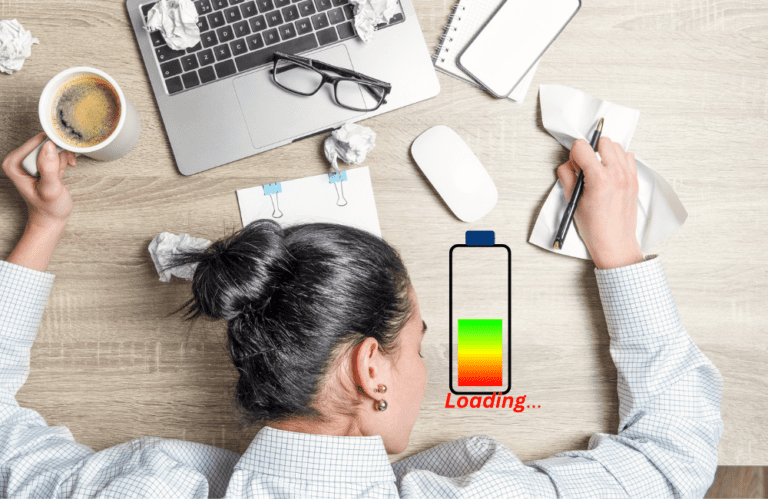Always Rushing? Here’s Why ADHD Brains Misjudge Time (and How to Fix It)
If you constantly underestimate how long something will take (and end up rushing, missing deadlines, or feeling frustrated with yourself), you’ll be relieved to know there’s a name for it! Well, maybe you knew—I didn’t. It’s called the Planning Fallacy, and ADHD brains are especially prone to it.
Here’s why it happens and what you can do about it.
Why ADHD Brains Struggle with Time Estimates
Your brain prioritizes the idea of a task, not the execution.
- You picture the finished project (clean apartment, dishes washed and stored, organized emails).
- But your brain skips over the boring middle part—all the tiny steps that actually make it happen.
- So you assume you’ll get it done faster than reality allows.
Time feels abstract (a.k.a. time blindness)
ADHD brains don’t track time naturally.
- We underestimate how long boring tasks will take because we assume we’ll be focused.
- We overestimate how long fun tasks will take because hyperfocus makes time disappear.
- We think “future us” will be different (“I’ll wake up early and finish this in an hour!”).
But future you is still you—still distracted, still underestimating, still human.
Backed by Science: Why ADHD Brains Underestimate Time
1. The Planning Fallacy
Coined by psychologists Daniel Kahneman and Amos Tversky, the Planning Fallacy explains why people consistently underestimate how long things take—even when they’ve done them before.
ADHD brains struggle with this even more due to impulsivity and weak executive function.
2. Time Blindness & Executive Dysfunction
- Time blindness is the ADHD brain’s inability to accurately sense and track time.
- Without external cues (like timers or deadlines), tasks feel abstract and distant, making procrastination more likely.
3. The “Double It” Rule & Time Estimation Research
- ADHD affects task initiation, meaning that even if you want to start, your brain struggles to switch into action mode.
- This is why breaking tasks into smaller, low-resistance steps (like the 5-minute rule) is so effective.
4. The “Double It” Rule & Time Estimation Research
- Research by Buehler et al. (1994) found that most people underestimate time by 50%, but ADHD brains can underestimate it even more due to impulsivity and optimism bias.
- Doubling your time estimates helps account for distractions, forgotten steps, and mental fatigue.
? Takeaway: If you think a task will take 30 minutes, plan for 60. Your brain will thank you.
So, How Do You Fix It?
1. Use the “Double It” Rule
Whatever time you think it will take—double it.
- Think writing that email will take 10 minutes? Give yourself 20.
- Think cleaning will take an hour? Block off two.
This builds in a time cushion for distractions, forgotten steps, and realistic pacing.
2. Track How Long Things Actually Take
- Set a timer before you start a task.
- Check it when you finish.
- Compare it to how long you thought it would take.
Do this for a few days, and you’ll start to see patterns in where your time actually goes.
3. Break It Down More Than You Think You Need To
Here’s an example in my own life.
Instead of:
❌ Write blog post – 1 hour
Reframe:
1. Outline blog post (15 min)
2. Write first draft (30 min)
3. Edit & format (20 min)
Each step feels smaller, making it easier to estimate (and easier to start).
4. Use an “Oops Buffer”
Always build in extra time for the unexpected.
- If you think you’ll finish work at 5 PM, tell yourself 5:30 (because something always comes up).
- If you need to leave at 2 PM, aim for 1:45 (so you’re not rushing at the last second).
- ADHD brains do better with flexible time cushions instead of tight deadlines.
5. Time Yourself for Motivation
ADHD brains love urgency.
- Set a 15-minute timer and see how much you can get done.
- This stops you from dragging out tasks longer than needed.
- If the timer goes off and you’re not done? At least you now know how long it really takes.
Final Thoughts
Underestimating time isn’t a personal failure—it’s how ADHD brains naturally function. The trick isn’t to “try harder” but to hack your brain using time buffers, timers, and realistic estimates.
Start with the “Double It” rule today and see how it changes your time perception. You might finally stop feeling like time is slipping away!






